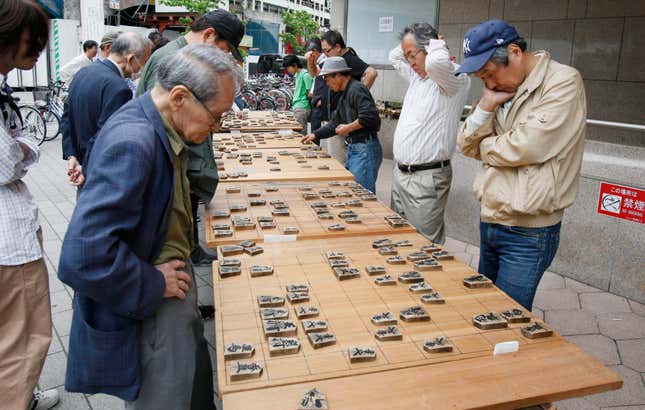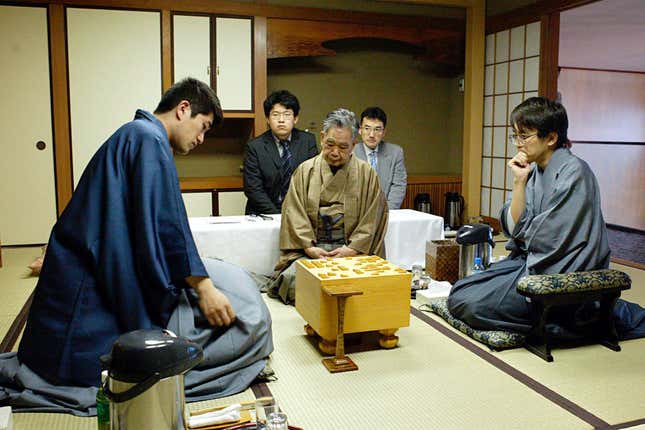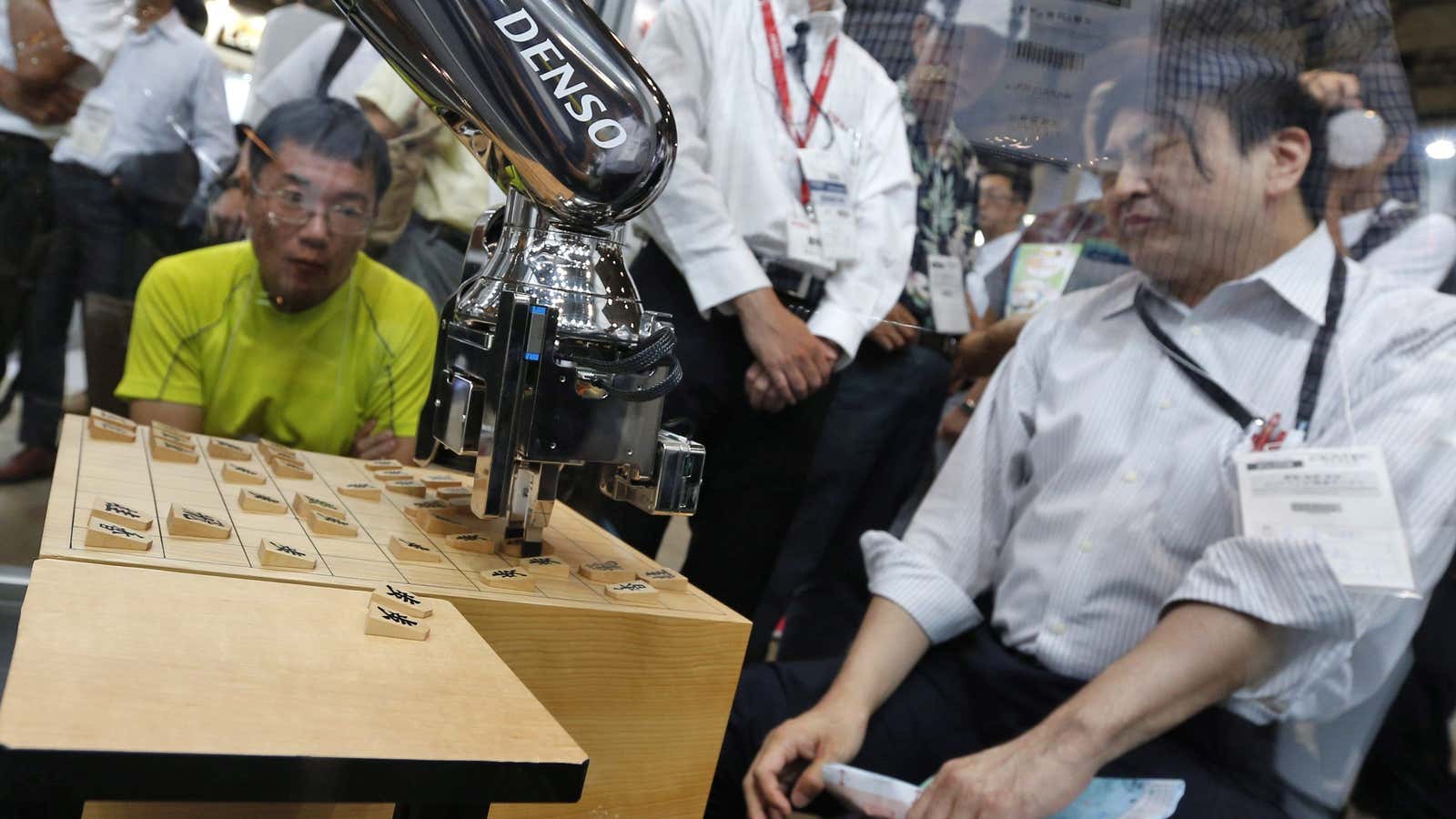Japan’s embrace of modern technology has never been fully comfortable or all-encompassing. Robot animals keep nonagenarians company in nursing homes, even as banking remains firmly stuck in the past. Robot dinosaurs tend to guests at a hotel, while fax is still a widely used form of communication.
The world of shogi, Japan’s answer to chess and Go, is now grappling with the rise of the robots. Last year, the country was shaken by an alleged cheating scandal when a top-ranked shogi player, Hiroyuki Miura, was accused by other players of cheating after he won a tournament in October. His opponents raised suspicions because Miura had repeatedly left the room during a match—insinuating that he went to use his phone to check what the best moves were. Miura, who denied wrongdoing, was suspended by the Japan Shogi Association (JSA) as they investigated the claims.
An “unprecedented crisis”
Miura was eventually cleared of wrongdoing after an investigation, and the head of the JSA stepped down in November as a result. But the ugly episode exposed deep-seated fears that computers are finally challenging in a serious way one of Japan’s most sacred art forms, on a par with traditions such as sumo wrestling and flower arrangement (ikebana). Shogi professionals, who wear traditional Japanese dress during title matches, are popularly known and celebrated. Newspapers (link in Japanese) and television stations (link in Japanese) dedicate coverage to games, and games are also streamed live online.

The trepidation is reminiscent of what happened when Google’s AlphaGo beat the world’s top Go player, Lee Sedol, last March in Seoul. Many had believed then that AI would not be able to beat a top Go player for at least another decade.
“Shogi players are very respected in Japan. There is a real fear that their status in Japan could be threatened by AI,” said Noboru Kosaku, a shogi player and a researcher on the amusement industry at the Osaka University of Commerce.
Kosaku explained that Japan’s reverence for shogi dates back to the Heian period (794 to 1185), when it was played by monks and samurai alike, and was a symbol of intelligence that was also loved by commoners. There is something “profound,” he said, in shogi culture’s emphasis on respect for ones opponents, whether one wins or loses.
An article in Japanese publication Toyo Keizai (link in Japanese) on Jan. 4 described the near-scandal and the rise of AI as an “unprecedented crisis for the shogi world,” and warned that the fear of AI was creating “feelings of doubt and suspicion” among the shogi community. The Asahi Shimbun, one of Japan’s biggest newspapers, warned of the “artificial monster” of AI.
“How will pro shogi players recover their trust in one another, not to mention the trust of shogi fans?” the newspaper asked.
Shogi
vs. chess
While Deep Blue managed to beat chess master Garry Kasparov in 1997, it wasn’t until 2012 that a computer vanquished a retired shogi pro. An active pro fell the following year. Shortly after that, AI programs won in a series of high-level matches, known as the Den-onsen.
“The human defeat in Den-onsen made most Japanese people aware for the first time of the hard reality that, through continued development, AI was beginning to drag humans down from the leading role in intellectual activities,” according to a paper written by Matake Kamiya, a professor of international relations at the National Defense Academy of Japan, and Sato Yasumitsu, chairman of the Professional Shogi Players Association. One of the defeated players was Miura—the player at the center of last year’s brouhaha—who with typical Japanese contriteness apologized for “failing to fulfill” his duty to beat the computer.
Shogi is seen to be a more difficult game than chess because once players capture an opponent’s piece, they can use that piece as their own—meaning that while chess games on the whole get simpler as fewer pieces are left on the board, shogi gets more complex, a shogi professional told the New York Times (paywall) in 1999. Shogi is played on a 9×9 grid with an average game length of 110 moves, and chess on a 8×8 grid with an average game length of 80 moves. There are about 10120 possible moves in chess, compared to 10220 for shogi—the number one followed by 220 zeros.

The goodness of humans
Koji Tanagawa, the JSA chairman who resigned after last year’s incident, later said the situation could have been avoided if the association had taken steps to change the rules to prevent any misconduct. The World Chess Federation, or FIDE, banned players from bringing mobile phones or similar devices into the gaming venue in 2014, as well as from leaving the playing venue without permission from the arbiter.
But as a testament to Japan’s reverence for shogi players, such rules were not drawn up until last year’s uproar. As of last December (link in Japanese), contestants are no longer allowed to bring smartphones and other devices into matches, or leave the shogi hall while a match is in process. Previously, players could look at their smartphones when they went for breaks. Now their gadgets must be kept in lockers.
At its root, shogi relies on seizensetsu, or the belief that humans are fundamentally good. Yoshiharu Habu, a professional shogi player, told the Sankei newspaper (link in Japanese) last year after the new regulations were announced: “Seizensetsu is fundamental to the world of shogi, but I suppose we may be entering an era where we can no longer just stick to that.”
The new head of the JSA, Yatsumitsu Sato, who was appointed earlier this month, vowed in his first speech (link in Japanese) in the role to bring shogi up-to-date with the times, while at the same time safeguarding the honor and tradition of “one of the world’s most intelligent games.”
Growing fears of the power of AI in shogi are also apparent in popular culture. A recently released comic book translated as The Eternal Hand (link in Japanese) predicts that the shogi world will begin to be destroyed by computers in 2030, with human players plummeting in popularity and eventually succumbing to work with computers, the new “masters” of the game.
Late last year, a film about shogi player Satoshi Murayama called Satoshi no Seishun hit Japanese cinemas. It shows Murayama, who died at 29 in 1997, delivering one of his most famous proclamations: “The day will never come when a computer defeats a pro shogi player.”
